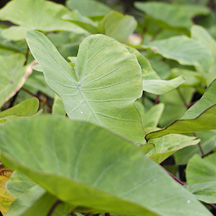|
In the Garden
|
Ubiquitous kalo
can regenerate
Colocasia esculenta
Distribution: A Polynesian introduction found on all the main islands. Entire valleys were sometimes terraced with lo'i (taro patches) to support cultivation.
![]()

'Uahiapele, 'elepaio and lauloa Kalo varieties can be found at the Home Depot in 2- gallon pots for about $11.
Kalo had a prominent place in Hawaiian mythology and religious rituals. Some varieties were used to make dye, while others were used for gluing kapa together. It was also used as bait for catching 'opelu, a type of island mackerel.
Description: There are numerous kalo varieties in Hawaii. More than 300 different cultivars have been noted. So although these plants are listed as Polynesian introductions, each cultivar is unique to Hawaii.
Their size varies from 2 to 5 feet or more, depending on the richness of the soil. Colors and patterns vary greatly as well, with some plants having plain green leaves, others like the 'elepaio variety having variegated green-and-white patterns, or purple-and-green patterns like the 'uahiapele variety. The stem color can be white, pink, red, green, black, or black with green stripes. Leaf shape also varies, but all have a general heart shape that might possess deeper cleavage than others (piko varieties) or curve like a bowl ('apuwai).
Landscape uses and care: Kalo is a great accent or ornamental plant. You can even build a kalo patch in your yard for sustenance. Your plant will become large and remain so for a few months, then slowly shrink when the corm is ready to be harvested, usually eight to 12 months after planting. The corm often emerges from the ground with little "keiki" sprouting from its sides.
It is important to harvest every eight to 12 months by cutting off about seven-eighths of the corm and leaves, then sticking the remaining stem with the one-eighth corm back in the ground to restart the cycle.
E-mail to Features Desk
[News] [Business] [Features] [Sports] [Editorial] [Do It Electric!]
[Classified Ads] [Search] [Subscribe] [Info] [Letter to Editor]
[Feedback]
